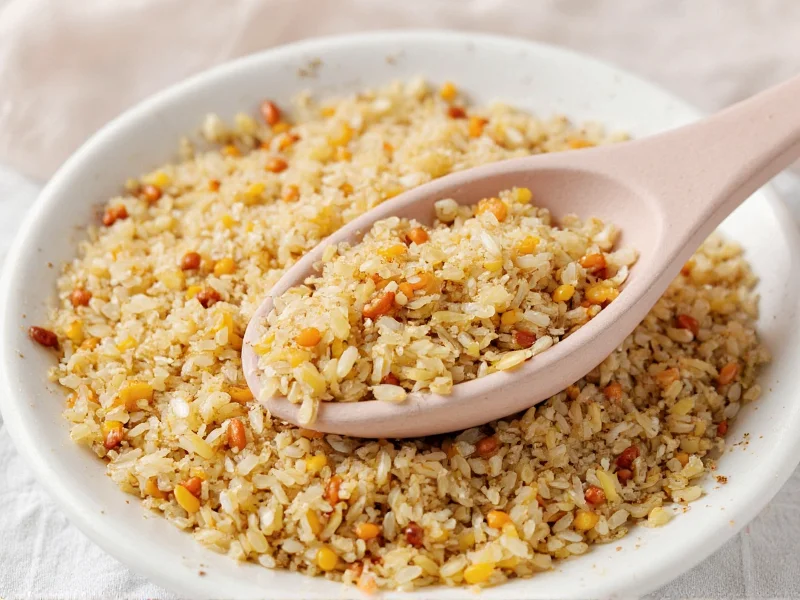Transforming simple rice into a flavorful side dish requires understanding the art of proper seasoning. While plain rice serves as a versatile canvas, the right seasoning blend can transport your meal across global cuisines—from fragrant jasmine rice enhanced with lemongrass and kaffir lime to Spanish rice infused with smoked paprika and garlic. Professional chefs and home cooks alike rely on carefully calibrated seasoning ratios to achieve restaurant-quality results without artificial additives.
Essential Components of Quality Rice Seasoning
Effective rice seasoning balances four fundamental elements: salt for flavor enhancement, aromatics for complexity, umami boosters for depth, and subtle acidity for brightness. The best blends maintain a 4:2:1:0.5 ratio of these components to prevent any single element from dominating. Onion and garlic powders serve as foundational aromatics, while nutritional yeast or dried shiitake mushroom powder provides natural umami without MSG. A touch of citric acid or dried lemon zest cuts through richness, creating a more vibrant finished dish.
Global Rice Seasoning Traditions
Cultures worldwide have developed distinctive rice seasoning approaches reflecting local ingredients and culinary traditions. Japanese furikake features nori, sesame seeds, and bonito flakes for umami richness. Mexican arroz rojo seasoning combines cumin, tomato powder, and chili for vibrant color and flavor. Indian ghee-infused rice often includes cardamom, cloves, and bay leaves for aromatic complexity. Understanding these cultural variations helps home cooks authentically replicate international dishes while respecting traditional flavor profiles.
Creating Custom Homemade Blends
Developing your own rice seasoning allows complete control over ingredients and flavor intensity. Start with a neutral base of 1 cup rice seasoning foundation (2/3 cup salt-free vegetable bouillon powder, 1/3 cup nutritional yeast), then customize with regional flavor profiles. The table below shows three versatile blends suitable for different cuisines:
| Seasoning Type | Key Ingredients | Ratio (per cup base) | Best Rice Pairings |
|---|---|---|---|
| Mediterranean Herb | Dried oregano, thyme, lemon zest, garlic powder | 2 tbsp herbs, 1 tbsp lemon, 1 tsp garlic | Basmati, jasmine, or brown rice |
| Asian Umami | Toasted sesame oil powder, ginger, scallion, white pepper | 1.5 tbsp sesame, 1 tbsp ginger, 2 tsp scallion | Short-grain, sushi rice, or jasmine |
| Southwest Spice | Smoked paprika, cumin, chili powder, cilantro | 1 tbsp paprika, 2 tsp cumin, 1 tsp chili | White or brown rice, cilantro-lime rice |
Professional Seasoning Techniques
Mastering rice seasoning requires attention to timing and method. For optimal flavor integration, add seasoning during the cooking process rather than after. When using homemade blends, toast the dry spices in the cooking pot before adding rice and liquid to bloom their flavors. For store-bought mixes, dissolve them completely in the cooking liquid to prevent uneven distribution. The ideal seasoning ratio is 1-2 teaspoons per cup of uncooked rice, adjusting based on personal preference and accompanying dishes. Remember that rice continues absorbing flavors as it rests, so slightly under-seasoning initially prevents oversalting.
Storage and Freshness Considerations
Homemade rice seasoning blends maintain peak flavor for 2-3 months when stored in airtight containers away from light and moisture. Glass jars with tight-sealing lids work best for preserving potency. Avoid storing blends containing fresh ingredients like citrus zest beyond one week. For extended shelf life, freeze seasoning blends in ice cube trays with a small amount of oil, then transfer the frozen portions to freezer bags. Properly stored, these frozen portions maintain quality for up to six months without flavor degradation.
Common Seasoning Mistakes to Avoid
Many home cooks make critical errors when seasoning rice that compromise results. Adding seasoning directly to hot cooked rice causes uneven distribution and potential clumping. Over-seasoning with salt-heavy blends creates an inedible dish, as rice absorbs salt during cooking. Using fresh herbs instead of dried versions results in inconsistent flavor and potential burning. Mixing incompatible flavor profiles (like adding curry powder to Spanish rice) creates confusing taste experiences. The most successful rice seasoning approaches maintain simplicity—choosing 2-3 complementary flavors rather than overwhelming the rice's natural character.
Frequently Asked Questions
What's the difference between rice seasoning and rice vinegar?
Rice seasoning refers to dry spice blends added during cooking, while rice vinegar is a liquid acid used after cooking or in sushi rice preparation. Seasoning blends enhance overall flavor profile with multiple ingredients, whereas rice vinegar primarily provides acidity and subtle sweetness. They serve different culinary purposes and aren't interchangeable in recipes.
Can I make rice seasoning without salt?
Yes, create salt-free rice seasoning using vegetable bouillon powder (check for sodium content), nutritional yeast, dried mushrooms, and acid components like citric acid or dried lemon zest. Replace salt's flavor-enhancing properties with umami-rich ingredients and balance with small amounts of sugar to round out flavors without sodium.
How much seasoning should I use per cup of rice?
Use 1-2 teaspoons of dry seasoning blend per cup of uncooked rice. Start with 1 teaspoon for milder flavors or when serving with strongly seasoned main dishes. Increase to 2 teaspoons for standalone rice dishes or when using more subtle seasoning blends. Always adjust based on personal preference and the specific blend's intensity.
Why does my seasoned rice taste bitter?
Bitterness typically comes from over-toasting spices, using old or rancid ingredients (especially sesame or nut components), or adding certain herbs like cilantro stems in excess. To fix bitter rice, add a small amount of acid (lemon juice or vinegar) and a touch of sweetness to balance flavors. For future batches, reduce toasting time and check ingredient freshness.











 浙公网安备
33010002000092号
浙公网安备
33010002000092号 浙B2-20120091-4
浙B2-20120091-4